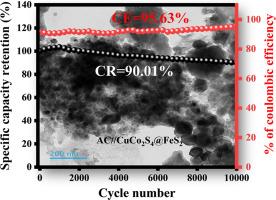MoF-derived CuCo2S4@FeS2 nanohybrids for supercapacitor applications
IF 5.5
3区 材料科学
Q1 ELECTROCHEMISTRY
引用次数: 0
Abstract
Metal-organic framework-derived CuCo2S4 nanomaterials are a potential target for supercapacitors, because of their structural and electrochemical features. In this study, we constructed nanohybrids of MoF-derived CuCo2S4 nanoparticles@FeS2 nanoplates using a solvothermal method. The presence of conductive carbon in the MoF-derived CuCo2S4 nanoparticles increases their electrical conductivity. MoF-derived CuCo2S4 exhibited a nanoparticle morphology and FeS2 exhibited a nanoplate morphology in HR-TEM resutls. The good surface area, porous structure with increseaed pore diameter of the hybrids of the CuCo2S4@FeS2 are offers the good super-capacitor performances. Nanostructured electrode materials have shortened ion diffusion paths and larger the contact areas for electrolyte ions. In a conventional three-electrode system, the hybrids of the CuCo2S4@FeS2 electrode delivered a capacity of 400.10 C g-1 at 1A g-1. Even, at a high current density of 10 A g-1, it delivered 210.19 C g-1 with an exceptional rate capability. Herein, the long-standing ability study demonstrated good capacity retention of 89.41 % after 5500 cycles. Furthermore, the AC//CuCo2S4@FeS2 device has a working voltage window of 0 - 1.5 V, and delivered the high capacity of 204.77 C g-1 @ 1 A g-1. After 10,000 cycles, 90.01 % capacity was retained at 5 A g-1 with a coulombic efficiency of 95.63 %. AC//CuCo2S4@FeS2 exhibited a maximum energy density of 63.99 Wh kg-1 at a power density of 1125 W kg-1 (1 A g-1), when increasing the current density to 5A g-1, the device maintained its energy/power density of 17.61 Wh kg-1 / 5625 W kg-1, respectively. Consequently, the exceptional characteristics exhibited by hybrids of CuCo2S4@FeS2 have established them as dependable contenders for implementation in supercapacitors.


超级电容器应用的mof衍生CuCo2S4@FeS2纳米杂化材料
金属有机框架衍生的CuCo2S4纳米材料由于其结构和电化学特性而成为超级电容器的潜在目标。在这项研究中,我们使用溶剂热方法构建了mof衍生的CuCo2S4 nanoparticles@FeS2纳米板的纳米杂化。mof衍生的CuCo2S4纳米颗粒中导电碳的存在提高了它们的导电性。在HR-TEM结果中,mof衍生的CuCo2S4表现为纳米颗粒形态,FeS2表现为纳米板形态。CuCo2S4@FeS2复合材料具有良好的比表面积、多孔结构和增大的孔径,提供了良好的超级电容器性能。纳米结构电极材料具有离子扩散路径缩短和电解质离子接触面积增大的特点。在传统的三电极系统中,CuCo2S4@FeS2电极的混合物在1A g-1时提供400.10 C g-1的容量。即使在10 a g-1的高电流密度下,它也能提供210.19 C g-1,并具有出色的速率能力。其中,长期能力研究表明,经过5500次循环后,容量保持率为89.41%。此外,AC//CuCo2S4@FeS2器件具有0 - 1.5 V的工作电压窗口,并提供204.77 C g-1 @ 1 a g-1的高容量。循环10000次后,在5 A g-1条件下,容量保留率为90.01%,库仑效率为95.63%。AC//CuCo2S4@FeS2在1125 W kg-1 (1 a g-1)功率密度下的最大能量密度为63.99 Wh kg-1,当电流密度增加到5A g-1时,器件的能量/功率密度分别保持在17.61 Wh kg-1 / 5625 W kg-1。因此,CuCo2S4@FeS2的混合材料所表现出的特殊特性使它们成为超级电容器中实现的可靠竞争者。
本文章由计算机程序翻译,如有差异,请以英文原文为准。
求助全文
约1分钟内获得全文
求助全文
来源期刊

Electrochimica Acta
工程技术-电化学
CiteScore
11.30
自引率
6.10%
发文量
1634
审稿时长
41 days
期刊介绍:
Electrochimica Acta is an international journal. It is intended for the publication of both original work and reviews in the field of electrochemistry. Electrochemistry should be interpreted to mean any of the research fields covered by the Divisions of the International Society of Electrochemistry listed below, as well as emerging scientific domains covered by ISE New Topics Committee.
 求助内容:
求助内容: 应助结果提醒方式:
应助结果提醒方式:


